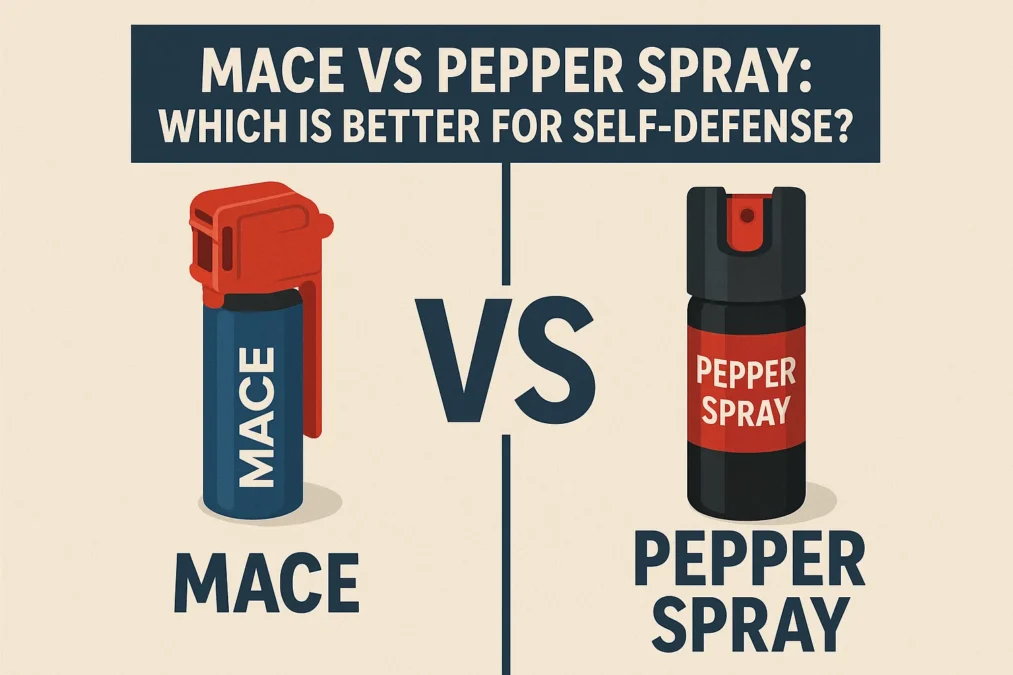Mace vs Pepper Spray: When it comes to personal safety, choosing the right self-defense tool can make all the difference. Two of the most popular options are mace and pepper spray. While they are often used interchangeably, they are not the same thing. Understanding the differences between mace vs. pepper spray, their effectiveness, and their applications can help you make an informed decision. Whether you’re considering bear mace vs. pepper spray or wondering about mace vs. pepper spray for self-defense, this guide has you covered.
What is Mace?
Mace, in its traditional form, is a chemical irritant that was first developed in the 1960s. Its active ingredient, phenacyl chloride (CN), is similar to tear gas. Originally used by law enforcement, mace was designed to incapacitate attackers by causing irritation to the eyes, nose, and throat. However, traditional mace has largely been phased out due to its limitations.
One of the biggest drawbacks of traditional mace is its ineffectiveness against individuals under the influence of drugs or alcohol. For example, someone high on PCP or other substances may not feel the effects of mace, making it unreliable in high-stress situations. Additionally, mace does not cause inflammation of the capillaries, which means it may not fully incapacitate an attacker.
Today, the term “mace” is often associated with the Mace® Brand, a trusted manufacturer of self-defense products, including pepper spray. This has led to some confusion, as many people now use “mace” to refer to pepper spray.
What is Pepper Spray?
Pepper spray, on the other hand, is an inflammatory agent made from oleoresin capsicum (OC), a derivative of hot peppers. When sprayed, it causes immediate and intense burning, swelling of the mucous membranes, and temporary blindness. Unlike traditional mace, pepper spray is highly effective against individuals under the influence of drugs or alcohol.
A single one-second blast of pepper spray can incapacitate an attacker for 15 minutes to over an hour. Its effects include coughing, choking, nausea, and difficulty breathing. The oily residue of pepper spray also makes it difficult to wash off, prolonging its effectiveness.
Pepper spray is widely regarded as one of the most effective non-lethal self-defense tools available. It’s used by law enforcement, security personnel, and civilians alike. Whether you’re considering bear mace vs. pepper spray or looking for a reliable self-defense option, pepper spray is often the preferred choice.
Mace vs Pepper Spray: Key Differences
1. Active Ingredients
- Mace (CN): Contains phenacyl chloride, a chemical irritant similar to tear gas.
- Pepper Spray (OC): Contains oleoresin capsicum, derived from hot peppers.
2. Effectiveness
- Mace: May not work on individuals under the influence of drugs or alcohol.
- Pepper Spray: Effective against all individuals, including those under the influence.
3. Effects
- Mace: Causes irritation to the eyes, nose, and throat but does not cause inflammation.
- Pepper Spray: Causes intense burning, swelling, and temporary blindness.
4. Duration
- Mace: Effects may wear off quickly.
- Pepper Spray: Effects can last up to an hour or more.
5. Legal Status
- Both mace and pepper spray are regulated, but laws vary by state and country. Always check local regulations before purchasing.
Mace vs. Pepper Spray for Self-Defense
When it comes to self-defense, pepper spray is generally the better option. Its ability to incapacitate an attacker quickly and effectively makes it a reliable choice for personal safety. Whether you’re walking alone at night or hiking in bear country, pepper spray can provide peace of mind.
However, it’s important to note that not all pepper sprays are created equal. Some products combine pepper spray with tear gas (CS) for added effectiveness. These combination sprays can be a good option, but they may not be legal in all areas.
Bear Mace vs. Pepper Spray
If you’re an outdoor enthusiast, you might be wondering about bear mace vs. pepper spray. Bear mace is a specialized form of pepper spray designed to deter aggressive bears. It has a higher concentration of OC and a longer range than standard pepper spray.
While bear mace can technically be used for self-defense against humans, it’s not recommended. The higher concentration and longer range make it more difficult to control, increasing the risk of accidentally spraying yourself or others.
How to Use Mace and Pepper Spray Safely
Using mace or pepper spray effectively requires proper training and practice. Here are some tips to keep in mind:
- Aim for the Face: The eyes, nose, and mouth are the most sensitive areas.
- Use Short Bursts: A one-second spray is usually enough to incapacitate an attacker.
- Practice: Consider using a training spray to get comfortable with the device.
- Check Expiration Dates: Mace and pepper spray can lose potency over time.
Legal Considerations
Before purchasing mace or pepper spray, it’s important to understand the laws in your area. Some states have restrictions on the size, concentration, and type of spray you can carry. For example, certain states prohibit the use of combination sprays that contain both pepper spray and tear gas.
Dolby Cinema vs IMAX Which Offers the Ultimate Movie Experience?
FAQs
1. Is mace the same as pepper spray?
No, mace and pepper spray are different. Traditional mace contains phenacyl chloride (CN), while pepper spray contains oleoresin capsicum (OC).
2. Which is better for self-defense: mace or pepper spray?
Pepper spray is generally more effective for self-defense, especially against individuals under the influence of drugs or alcohol.
3. Can I use bear mace for self-defense against humans?
While bear mace can be used against humans, it’s not recommended due to its higher concentration and longer range.
4. How long do the effects of pepper spray last?
The effects of pepper spray can last anywhere from 15 minutes to over an hour.
5. Is pepper spray legal in all states?
Pepper spray is legal in most states, but regulations vary. Always check local laws before purchasing.
Conclusion
When it comes to mace vs. pepper spray, the choice ultimately depends on your specific needs. For most people, pepper spray is the better option due to its effectiveness and reliability. However, it’s important to choose a product that suits your situation and to familiarize yourself with its proper use.
Whether you’re considering bear mace vs. pepper spray or looking for the best self-defense tool, understanding the differences between these products can help you make an informed decision. Stay safe and empowered with the right self-defense solution.
By understanding the nuances of mace vs. pepper spray, you can make an informed decision that prioritizes your safety. Whether you’re hiking in the wilderness or walking through the city, having the right self-defense tool can give you the confidence to face any situation.
Key Quotes on Mace vs. Pepper Spray
On Definitions and Origins:
- “Mace, in its traditional form, is a chemical irritant that was first developed in the 1960s. Its active ingredient, phenacyl chloride (CN), is similar to tear gas.”
- “Pepper spray… is an inflammatory agent made from oleoresin capsicum (OC), a derivative of hot peppers.”
- “Today, the term ‘mace’ is often associated with the Mace® Brand… This has led to some confusion, as many people now use ‘mace’ to refer to pepper spray.”
On Effectiveness:
- “One of the biggest drawbacks of traditional mace is its ineffectiveness against individuals under the influence of drugs or alcohol.”
- “Unlike traditional mace, pepper spray is highly effective against individuals under the influence of drugs or alcohol.”
- “A single one-second blast of pepper spray can incapacitate an attacker for 15 minutes to over an hour.”
On Bear Spray:
- “Bear mace is a specialized form of pepper spray designed to deter aggressive bears. It has a higher concentration of OC and a longer range than standard pepper spray.”
- “While bear mace can technically be used for self-defense against humans, it’s not recommended. The higher concentration and longer range make it more difficult to control…”
On Legal and Safety Considerations:
- “Both mace and pepper spray are regulated, but laws vary by state and country. Always check local regulations before purchasing.”
- “Using mace or pepper spray effectively requires proper training and practice.”
Comparison Table: Mace vs. Pepper Spray
| Feature | Traditional Mace (CN) | Pepper Spray (OC) | Modern “Mace” Brand Products |
|---|---|---|---|
| Active Ingredient | Phenacyl Chloride (CN) – a chemical irritant similar to tear gas. | Oleoresin Capsicum (OC) – a natural derivative of hot peppers. | Often a blend of OC and CN, or pure OC. (Check the label) |
| Primary Effect | Irritant. Causes pain, tearing, and difficulty breathing. | Inflammatory. Causes burning pain, swelling of mucous membranes, and temporary blindness. | Varies by product, but typically combines inflammatory and irritant effects. |
| Effectiveness | Less reliable. Often ineffective on individuals under the influence of drugs or alcohol. | Highly reliable. Effective on everyone, including those under the influence. | Generally very reliable, depending on the formula. |
| Duration of Effects | Effects may wear off relatively quickly. | Effects are long-lasting (15 minutes to over an hour). | Long-lasting, similar to pepper spray. |
| Key Advantage | Historical use by law enforcement. | Proven, natural-based formula with high success rate. | Brand reputation and wide availability. |
| Key Drawback | Unreliable in many real-world scenarios; largely phased out. | Oily residue is difficult to wash off (a pro for stopping attackers, a con for cleanup). | The brand name causes common confusion with the less-effective original chemical. |
| Best For | Historical context. Not recommended for modern self-defense. | Personal self-defense against human attackers. | Personal self-defense; a trusted brand name. |
Comparison Table: Standard Pepper Spray vs. Bear Spray
| Feature | Standard Pepper Spray (for humans) | Bear Spray (for bears) |
|---|---|---|
| OC Concentration | Typically 1-2% Major Capsaicinoids. Lower concentration optimized for human physiology. | Typically 1-2% Major Capsaicinoids. The key difference is not strength but delivery. |
| Spray Pattern | Stream, cone, fog, or gel. Designed for accuracy at close range against a human face. | Wide fog cloud. Designed to create a barrier between you and a bear, affecting its sensitive nose and eyes. |
| Range | Short range (typically 10-15 feet). | Long range (typically 25-30 feet). |
| Canister Size | Small, compact, and easily carried on a person. | Large, bulky canister meant for a backpack holster. |
| Legality for Use | Legal for self-defense against humans in most areas (check local laws). | Regulated for animal use. Using it on a human may have serious legal consequences. |
| Effectiveness | Highly effective on humans. | Ineffective and dangerous to use on a human due to pattern and range. |
| Purpose | To incapacitate a human attacker at close range. | To deter an aggressive bear from a long range. |



